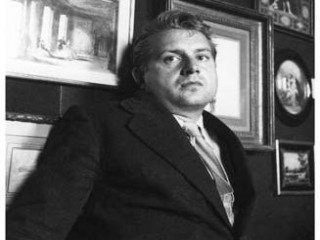
Francis Bacon biography
Date of birth : 1909-10-28
Date of death : 1992-04-28
Birthplace : Dublin, Ireland
Nationality : English
Category : Arts and Entertainment
Last modified : 2011-05-10
Credited as : Graphic artist, ,
The English artist Francis Bacon was one of the most powerful and original figure painters in contemporary art, particularly noted for the obsessive intensity of his work.
Francis Bacon (a collateral descendant of the great Elizabethan statesman and essayist of the same name) was born in Dublin on October 28, 1909, to English parents. He left home at the age of 16, and after spending two years in Berlin and Paris he settled in London with the intention of establishing himself as an interior decorator and furniture designer. However, he soon gave up interior decorating for painting, in which he was self-taught. The few early paintings that survive (he destroyed most of them) show that he began as a late cubist and then turned by 1932 to an agonized form of surrealism based partly on Pablo Picasso's works of about 1925 to 1928.
Bacon exhibited very rarely until 1945, and it was only after World War II that his paintings became known outside his immediate circle of friends. At this time he also began to paint the human figure, subjecting it at first to weird distortions and combining it with bizarre and disturbing imagery. The pictures that made his reputation are of such subjects as a vaporizing head in front of a curtain and a screaming figure crouching under an umbrella. These startlingly original works are impressive not only as a powerful expression of anguish but also for the grandeur of their presentation and painterly quality.
By the early 1950s Bacon had developed a more direct treatment of the human figure, working almost always from photographs rather than from life. Images taken from newspaper clippings or from the photographs of humans and animals in movement by the 19th-century photographer Eadweard Muybridge were sometimes combined with borrowings from the well-recognized paintings of the old masters. For instance, a series of paintings inspired by the portrait of Pope Innocent X by the Spanish painter Diego Velazquez also incorporate a screaming face and pince-nez derived from a close-up of a wounded nurse in Sergei Eisenstein's film The Battleship Potemkin. Such a combination of motifs drawn from completely unrelated sources is very characteristic of Bacon's work. At the same time contemporary imagery is given a grandeur presentation akin to that of 16th-and 17th-century painting.
From the 1950s through the end of Bacon's painting career and life in the early 1990s, the recurrent theme of his work was the isolation and anguish of the individual, with a single figure (usually male) seated or standing in a claustrophobic, windowless interior as if confined in a private hell. His subjects were artists, friends, lovers, and even himself. Working without preliminary studies and relying to a great extent on improvisation, Bacon used expressive deformations to extract every nuance of feeling and tension. His painting technique consisted of using rags, his hands and whorls of dust along with paint and brush.
Although Bacon had consistently denied the illustrational nature of his paintings, the facts of his life have tempted art critics and historians to draw links between his personal life and the subject matter of his paintings. One of the great tragedies of his life was the death, an apparent suicide, of his long time lover George Dyer. Dyer's death, the result of ingesting large quantities of drugs and alcohol, occurred just before the opening of Bacon's major retrospective in Paris, France, in 1971. Bacon's famous and moving Triptych—May-June 1973, was a three-paneled work of his dying friend hunched fetus-like on a toilet, shadowed in a door frame and vomiting into a sink. While admitting this to be his most personal work, Bacon was still loath to allow its narrative nature, insisting that the panels be framed individually to avoid the impact of storytelling.
In a period dominated by abstract art, Bacon stood out as one of the few great exponents of the figure-painting tradition. During the last decade of his life major retrospective exhibitions were mounted at such sites as the Marlborough Gallery in New York in 1984, Moscow in 1989, and the museum of Modern Art in New York in 1990. Bacon died of heart failure brought on by asthma in Madrid, Spain, on April 28, 1992.


















